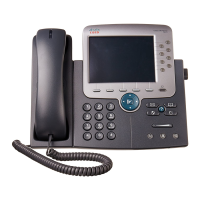4-31
Cisco Unified IP Phone 7975G Administration Guide for Cisco Unified Communications Manager 6.0
OL-12642-01
Chapter 4 Configuring Settings on the Cisco Unified IP Phone
Device Configuration Menu
Related Topics
• Displaying a Configuration Menu, page 4-2
• Network Configuration Menu, page 4-5
Peer Firmware
Sharing
The Peer Firmware Sharing feature
provides these advantages in high
speed campus LAN settings:
• Limits congestion on TFTP
transfers to centralized TFTP
servers
• Eliminates the need to manually
control firmware upgrades
• Reduces phone downtime during
upgrades when large numbers of
devices are reset simultaneously
In most conditions, Peer Firmware
Sharing optimizes firmware upgrades
in branch deployment scenarios over
bandwidth-limited WAN links.
When enabled, it allows the phone to
discover like phones on the subnet that
are requesting the files that make up the
firmware image, and to automatically
assemble transfer hierarchies on a
per-file basis. The individual files
making up the firmware image are
retrieved from the TFTP server by only
the root phone in the hierarchy, and are
then rapidly transferred down the
transfer hierarchy to the other phones
on the subnet using TCP connections.
This menu option indicates whether the
phone supports Peer Firmware Sharing.
Settings include:
• Enabled
• Disabled—default
Use Cisco Unified Communications
Manager
Administration
> Device > Phone >
Phone
Configuration.
Log Server Indicates the IP address and port of the
remote logging machine to which the
phone sends log messages. These log
messages help in debugging the Peer
Firmware Sharing feature.
Note The remote logging setting
does not affect the sharing log
messages sent to the phone log.
Use Cisco Unified Communications
Manager Administration
> Settings >
Device Configuration
> Network
Configuration.
Table 4-17 Network Configuration Menu Options (continued)
Option Description To Change

